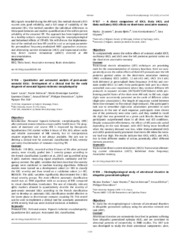Приказ основних података о документу
A direct comparison of tDCS, theta tACS, and theta‑oscillatory tDCS effects on short-term associative memory
| dc.creator | Živanović, Marko | |
| dc.creator | Bjekić, Jovana | |
| dc.creator | Konstantinović, Uroš | |
| dc.creator | Filipović, Saša R. | |
| dc.date.accessioned | 2023-09-21T13:23:51Z | |
| dc.date.available | 2023-09-21T13:23:51Z | |
| dc.date.issued | 2023 | |
| dc.identifier.uri | http://reff.f.bg.ac.rs/handle/123456789/4856 | |
| dc.description.abstract | Objectives: To comparatively assess the online effects of constant anodal tDCS, oscillatory tDCS, and tACS over the left posterior parietal cortex on the short-term associative memory. Content: Transcranial electric stimulation (tES) techniques are promising tools for the neuromodulation of memory functions. Here, we comparatively assess the online effects of three tES protocols over the left posterior parietal cortex on the short-term associative memory (AM): oscillatory tDCS (otDCS, 1.5 mA ± 0.5 mA), tACS (0 ± 1 mA), both delivered at personalized theta frequency (4–8 Hz) and constant anodal tDCS (1.5 mA). Forty participants took part in a sham-controlled cross-over experiment where they received different tES protocols in separate sessions (tDCS/otDCS/tACS/sham) while performing parallel forms of the short-term AM task. In AM task, single digits were successively presented on the cards of different colors (digit-color associations). The length of sequences varied between three (low-demand) to five stimuli (high-demand). The participant’s task was to remember digit-color associations presented in each sequence. At the end of each sequence, participants were shown one of the previously seen color cards, and they needed to recall the digit that was presented on a given card. Results showed that participants outperformed sham in all three real tES conditions. Despite comparable effectiveness, the effects of tES protocols varied depending on the task demand, with tDCS being more beneficial when the memory demand was low, while theta-modulated tACS and otDCS predominantly promoted short-term AM when the memory load was high. The results indicate that tDCS, otDCS, and tACS, due to their different modes of action, potentially affect different memory processes. | sr |
| dc.language.iso | en | sr |
| dc.relation | Horizon Europe - project “Twinning for excellence in non-invasive brain stimulation in Western Balkans” (project no 101059369) | sr |
| dc.relation | info:eu-repo/grantAgreement/MESTD/inst-2020/200163/RS// | sr |
| dc.relation | info:eu-repo/grantAgreement/MESTD/inst-2020/200015/RS// | sr |
| dc.rights | openAccess | sr |
| dc.rights.uri | https://creativecommons.org/licenses/by/4.0/ | |
| dc.source | Clinical Neurophysiology | sr |
| dc.subject | transcranial direct current stimulation (tdcs) | sr |
| dc.subject | transcranial alternating current stimulation (tacs) | sr |
| dc.subject | individual theta frequency | sr |
| dc.subject | associative memory | sr |
| dc.title | A direct comparison of tDCS, theta tACS, and theta‑oscillatory tDCS effects on short-term associative memory | sr |
| dc.type | conferenceObject | sr |
| dc.rights.license | BY | sr |
| dc.citation.epage | e122 | |
| dc.citation.spage | e122 | |
| dc.citation.volume | 150 | |
| dc.description.other | Abstracts of the 18th European Congress of Clinical Neurophysiology (ECCN), Marseille, France, May 9–12, 2023 | |
| dc.identifier.doi | 10.1016/j.clinph.2023.03.156 | |
| dc.identifier.fulltext | http://reff.f.bg.ac.rs/bitstream/id/11868/1-s2.0-S1388245723003875-main-2.pdf | |
| dc.type.version | publishedVersion | sr |

